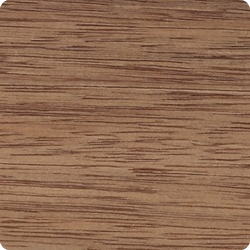Detailed Specs: Basralocus
Scientific Name: Dicorynia guianensis
Family: Leguminosae
Other Names: Basralokus, Barakaroeballi (Suriname), Angelique batard, Angelique gris (French Guiana), Wamaradan, Wamaradang (Guyana)
The Tree:
Well-formed tree grows to a height of 150 feet and diameters to 5 feet but more commonly to 3 feet. Boles are clear for 60 to 80 feet over heavy buttresses.
The Wood
General Characteristics: Heartwood is reddish brown, grey to reddish or yellowish brown sharply demarcated from narrow brownish-white sapwood. Texture is medium with an unusual subsurface luster; grain is usually straight, sometimes somewhat interlocked; no distinctive odour or taste. Vessels are prominent as long brown lines on the side grain producing an attractive figure. Silica content has been reported as 0.21-1.70% and as high as 2.92%.
Weight: Basic specific gravity (oven dry weight/ green volume) 0.65; air-dry density 50 pcf.
Drying and Shrinkage: Moderately difficult to season, dries rapidly but with a tendency to moderate checking and slight warping. A kiln schedule similar to T2-B2 has been suggested. Shrinkage green to oven dry: radial 4.6%; tangential 8.2%; volumetric 14.0%. It has been reported to hold well in place after manufacture. The heartwood is resistant to moisture absorption.
Working Properties: This varies according to density and silica content but generally works well and finishes smoothly. Specially tipped cutters are suggested particularly for dried wood, however, it glues well.
Mechanical Properties: (2-in standard)
|
Moisture |
Bending Strength (psi) |
Modules of Elasticity (1000 psi) |
Maximum Crushing Strength (psi) |
| Green (75)
12% |
11,410
17,390 |
1,840
2,190 |
5,590 8,770 |
Janka side hardness 1,100 lb, for green material and 1,290 lb at 12% moisture content. Forest Products Laboratory toughness average for green and air dry material is 151 in-lb. (5/8-in specimen).
Durability: Heartwood is resistant to very resistant to attack by decay fungi but is somewhat susceptible to dry -wood termites. The wood is resistant to attack by marine borers.
Distribution: Abundant in eastern Suriname and western French Guiana where it may make up 10% of the forest stands. Best grown on deep, loamy, well drained soils of lowland plains but also found in wet areas.
Uses: Marine construction and generally heavy construction, railroad crossties, industrial flooring, ship decking, planking and framing, piling, parquet blocks and strips.
References
– Chundnoff, Martin (1984), “Tropical Timbers of the World.” USDA Forest Service Ag. Handbook No.607.



